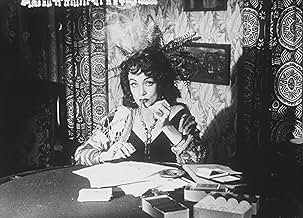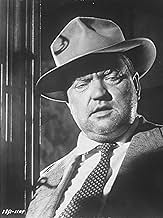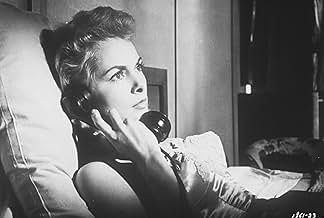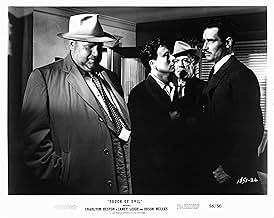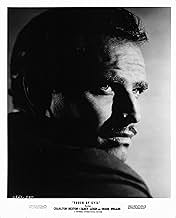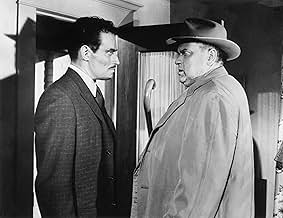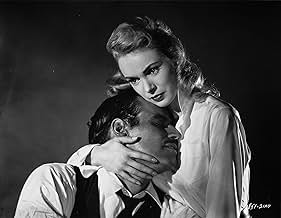Une histoire brutale et perverse de meurtre, d'enlèvement et de corruption policière dans une ville frontalière du Mexique.Une histoire brutale et perverse de meurtre, d'enlèvement et de corruption policière dans une ville frontalière du Mexique.Une histoire brutale et perverse de meurtre, d'enlèvement et de corruption policière dans une ville frontalière du Mexique.
- Prix
- 7 victoires et 1 nomination au total
Valentin de Vargas
- Pancho
- (as Valentin De Vargas)
Avis en vedette
Touch of Evil has, perhaps, the BEST cinematography and lighting in ANY film ever made. Not just in the film noir genre, but in all categories. Orson Welles tended to use wide shots for all of his films, and Touch of Evil's use of wide shots took filmmaking to another level, especially with the amazing opening shot. The camera techniques and lighting are too spectacular to fathom, it is the grandmaster of all movies. Brilliant is an understatement. See this film, if not for the excellent acting and sheer brilliance in terms of the camera (this film had a GREAT D.P.!!), but for entertainment value. But if you are a film student or just want to see great camera work, Touch of Evil will astonish you.
10Dr.Teeth
There are only two ways to write a review that would truly do this film justice. Either one would have to write an exceedingly long review, or a short, concise one. I choose to do the latter.
When I first saw "Touch of Evil," I was glued to the chair. When I found out it was not Welles' definitive vision, I wondered how on earth it could have been made better. And when I saw the re-released version, I wondered why the studio altered it. The stunning black-and-white images, the intricate plot, and the powerful, engaging performances took a hold of my imagination. At times, I imagined myself on the street with the characters, because the atmosphere was so thick I felt surrounded in it.
The actors all did an outstanding job, especially Leigh and Heston (who, although not thoroughly convincing as a Mexican, soared above his usual powerful, furious presence). This is Welles' picture, however, and whenever the camera catches his obese figure, you are fully aware of the man as a director and an actor. His powerful vision drives the film, from the single-cut opening sequence to the cat-and-mouse finale.
I suggest watching the 1998 restored version over the original theatrical release, but regardless of which version, "Touch of Evil" will have you stuck in your seat, questioning your views of morality until long after the last credit has rolled up the screen.
When I first saw "Touch of Evil," I was glued to the chair. When I found out it was not Welles' definitive vision, I wondered how on earth it could have been made better. And when I saw the re-released version, I wondered why the studio altered it. The stunning black-and-white images, the intricate plot, and the powerful, engaging performances took a hold of my imagination. At times, I imagined myself on the street with the characters, because the atmosphere was so thick I felt surrounded in it.
The actors all did an outstanding job, especially Leigh and Heston (who, although not thoroughly convincing as a Mexican, soared above his usual powerful, furious presence). This is Welles' picture, however, and whenever the camera catches his obese figure, you are fully aware of the man as a director and an actor. His powerful vision drives the film, from the single-cut opening sequence to the cat-and-mouse finale.
I suggest watching the 1998 restored version over the original theatrical release, but regardless of which version, "Touch of Evil" will have you stuck in your seat, questioning your views of morality until long after the last credit has rolled up the screen.
Here is a film that wouldn't be made today because nobody makes 'B' movies anymore; and this is the greatest 'B' movie in the history of cinema. Here is the perfect example of why Orson Welles should be considered a genius. He has made this film look so effortlessly easy that it could almost be considered film making by numbers. From the famous opening sequence to the closing titles, this is the film students' reference book.
Welles portrayal of the bloated cop Hank Quinlan is only bettered by his Harry Lime in 'The Third Man'. He gets right inside the seedy, corrupt Quinlan; but still leaves room for just the lightest touch sympathy because we know that, after all, he's a fallible human like all of us. We almost feel sad at his fate especially when Marlene Dietrich gives her sad soliliquay about him.
This is another film that can only exist in black and white, and begs the question, why can't directors work effectively in this medium today? Some have tried but none have have really suceeded. David Lynch's Eraserhead is probably the best modern example of a black and white only film. Woody Allen's Manhattan tries hard but ends up looking too much like a documentary. I don't think that directors today use this medium enough, too many rely on colour and the efffects that can only work in colour to get them out of trouble.
So put A Touch Of Evil on your 'must see' list and enjoy a work of film making artistry.
Welles portrayal of the bloated cop Hank Quinlan is only bettered by his Harry Lime in 'The Third Man'. He gets right inside the seedy, corrupt Quinlan; but still leaves room for just the lightest touch sympathy because we know that, after all, he's a fallible human like all of us. We almost feel sad at his fate especially when Marlene Dietrich gives her sad soliliquay about him.
This is another film that can only exist in black and white, and begs the question, why can't directors work effectively in this medium today? Some have tried but none have have really suceeded. David Lynch's Eraserhead is probably the best modern example of a black and white only film. Woody Allen's Manhattan tries hard but ends up looking too much like a documentary. I don't think that directors today use this medium enough, too many rely on colour and the efffects that can only work in colour to get them out of trouble.
So put A Touch Of Evil on your 'must see' list and enjoy a work of film making artistry.
When anyone mentions this masterpiece they usually make some ignorant remark about Charlton Heston not being believable as a Mexican. Apparently such people think all Mexicans resemble the ones they've seen in the US who are mostly mestizo - 60% of Mexicans are Mestizo, 30% Indian and about 10% European. Well, Mexico's ruling class is predominantly of European ethnicity, and today many are educated in the US and so they speak fluent English with an American accent. Charlton Heston is playing a man who is a member of that elite and is thus believable in the role in terms of his physical appearance and possibly even his accent. The only problem came when his character had to speak Spanish! Now there he had a problem...
We start with a man putting a bomb in a car on the Mexican side of the border. When it explodes on the American side flattening the occupants, the local "Capt. Quinlan" (Orson Welles) decides to make a bit of a cursory investigation - in cahoots with his opposite number "Vargas" (Charlton Heston). Whilst they are out doing their sleuthing, "Susan Vargas" (Janet Leigh) is lured to a meeting with "Uncle Joe" (Akim Tamiroff) where it becomes clear that her husband is on the prosecuting side of a family dispute that is putting everyone in danger - something her husband finds out shortly afterwards when he narrowly avoids an acid facial. Now "Quinlan" and his sidekick "Menzies" (Joseph Calleia) have a rather unique way of working - the former intimidates just with his presence and has the District Attorney in his pocket, but as this investigation starts to spread out the original crime pails into insignificance as "Susan" finds herself trapped in an out of town motel and the potential victim of a ghastly drug crime that brings the threads of the story - and the true criminality to light - fatally. There are five principal characters and the actors do justice to them all - the story moves along darkly offering plenty of interest, the odd red herring and a particularly strong effort from Welles as the increasingly unlikeable policeman. I was slightly dubious about Heston playing a Mexican policeman, but here carries of the role in one of his better screen performances (when he is not wearing leather garments) and Janet Leigh - well, she was always an actor who made it all look effortless. The ending combines the scary with the brutal but will the truth be out? Big screen must for the full potency of the last twenty minutes.
Le saviez-vous
- AnecdotesJanet Leigh's agent initially rejected her participation in this film due to the low salary offered without even consulting the actress. Orson Welles, anticipating this, sent a personal letter to the actress, telling her how much he looked forward to their working together. Leigh, furious, confronted her agent telling him that getting directed by Welles was more important than any paycheck.
- GaffesThe car that blows up four minutes into the film has the Texas plate AG 3724; 32 minutes into the film, police car number 10 also has the Texas plate AG 3724.
- Générique farfeluOpening statement (restored version): In 1957, Orson Welles completed principal photography on TOUCH OF EVIL and edited the first cut. Upon screening the film, the Studio felt it could be improved, shot additional scenes and re-edited it. Welles viewed this new version and within hours wrote a passionate 58-page memo requesting editorial changes. This version represents an attempt to honor those requests and make TOUCH OF EVIL the film Orson Welles envisioned it to be. "... I close this memo with a very earnest plea that you consent to this brief visual pattern to which I gave so many long hard days of work." -- Orson Welles
- Autres versionsA new version, running 111 minutes, has been restored by Universal and debuted at the Telluride Film Festival in September 1998. This version has been re-edited according to Orson Welles' original vision, as outlined in a 58-page memo that the director wrote to Universal studio head Edward Muhl in 1957, after Muhl took editing out of Welles' hands. The new version has been prepared by editor by Walter Murch, sound recordists Bill Varney, Peter Reale and Murch, and picture restorer Bob O'Neil under the supervision of Rick Schmidlin and film critic Jonathan Rosenbaum. One difference between the two versions is that the famous opening tracking shot is now devoid of credits and Henry Mancini's music, featuring only sound effects.
- ConnexionsEdited into American Cinema: Film Noir (1995)
- Bandes originalesMain Title (Touch of Evil)
Written by Henry Mancini
Performed by United International Orchestra;
Rolly Bundock (bass); Shelly Manne (drums); Barney Kessel (guitar); Jack Costanzo, Mike Pacheco (percussion); Ray Sherman (piano); Dave Pell (baritone sax); Plas Johnson (tenor sax)Conrad Gozzo, Pete Candoli, Ray Linn (trumpets) ;Red Norvo (vibes)
Meilleurs choix
Connectez-vous pour évaluer et surveiller les recommandations personnalisées
Détails
- Date de sortie
- Pays d’origine
- Langues
- Aussi connu sous le nom de
- Sed de mal
- Lieux de tournage
- El Rancho Courson Motel, SW corner of E Barrel Springs Rd and Courson Ranch Road, Palmdale, Californie, États-Unis(Mirador Motel - now site of a residential cul-de-sac)
- société de production
- Consultez plus de crédits d'entreprise sur IMDbPro
Box-office
- Budget
- 829 000 $ US (estimation)
- Brut – États-Unis et Canada
- 2 247 465 $ US
- Fin de semaine d'ouverture – États-Unis et Canada
- 70 725 $ US
- 13 sept. 1998
- Brut – à l'échelle mondiale
- 2 285 063 $ US
- Durée1 heure 35 minutes
- Couleur
Contribuer à cette page
Suggérer une modification ou ajouter du contenu manquant

Lacune principale
By what name was Touch of Evil (1958) officially released in India in Hindi?
Répondre


